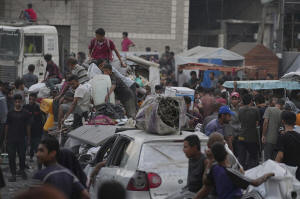Israeli military says strikes on Gaza hospital targeted a Hamas camera,
without providing evidence
[August 27, 2025]
By WAFAA SHURAFA, MELANIE LIDMAN and SAMY MAGDY
DEIR AL-BALAH, Gaza Strip (AP) — The Israeli military said Tuesday that
its double strike on a Gaza hospital that killed 20 people targeted what
it believed was a Hamas surveillance camera. But the first strike killed
a cameraman from the Reuters news agency doing a live television shot,
according to witnesses and health officials.
The military released its initial findings into the strike, offering no
immediate explanation for striking twice and no evidence for an
assertion that six of the dead were militants, including two who were
identified by their employers as a health care worker at the hospital
and an emergency services driver. The dead also included five
journalists.
The military said the back-to-back strikes on southern Gaza’s largest
hospital were ordered because soldiers believed militants were using the
camera to observe Israeli forces. But its account appeared to contradict
witnesses at the scene of Monday’s attack on Nasser Hospital.
A senior Hamas official denied that Hamas was operating a camera at the
hospital.
“If this claim was true, there are many means to neutralize this camera
without targeting a health care facility with a tank shell,” Bassem Naim,
a member of the group’s political bureau, told The Associated Press in a
phone interview.
Questions raised about Israeli military's account
An initial strike hit a top floor of one of the hospital’s buildings.
Reuters cameraman Hussam al-Masri was killed in that blast while filming
from the site, according to a fellow journalist and a doctor at the
hospital.

Hospital officials said a second person, who has not been identified,
was also killed in the first strike.
Health workers, journalists and relatives of patients then rushed up an
external staircase to reach the site of the first blast. Photos taken
from below showed at least 16 people gathered on the staircase, trying
to help those hit. Among them were four men wearing the orange vests of
emergency responders or health workers. No one on the staircase was seen
holding weapons.
Video footage taken by Al-Ghad TV shows the second strike hitting,
causing a large boom and engulfing everyone on the staircase in smoke.
Hospital officials say 18 people were killed in the second strike.
The military did not elaborate on why it struck a second time or how it
would have identified militants among the crowd on the staircase. Its
statement was issued after an initial inquiry into the attack, which
Israeli Prime Minister Benjamin Netanyahu called a “tragic mishap.” He
did not elaborate on the nature of any mistake.
Among the six people killed Monday that Israel claimed were militants
were Jumaa al-Najjar, a health care worker at Nasser Hospital, and Imad
al-Shaar, a driver with Gaza’s civil defense agency, which operates
under the Hamas-run Interior Ministry, according to the agency and
Nasser hospital’s casualty list.
Without offering evidence, Israel has in the past identified emergency
responders who work under the Hamas-run government as militants to be
targeted, including in the killing of 15 medics in March, when Israeli
troops opened fire on ambulances in southern Gaza.
The military’s chief of general staff acknowledged several “gaps” in the
investigation so far, including the kind of ammunition used to take out
the camera.
Rights groups condemn `double tap' attack on hospital
The initial findings emerged Tuesday as a surge of outrage and
unanswered questions mounted, after international leaders and rights
groups condemned the strikes.

“The killing of journalists in Gaza should shock the world,” said United
Nations Human Rights Office spokesperson Thameen Al-Kheetan. “Not into
stunned silence but into action, demanding accountability and justice.”
Among the journalists killed in the strikes was Mariam Dagga, who worked
for The Associated Press and other publications.
The Israel-Hamas war has been one of the bloodiest conflicts for media
workers, with 189 Palestinian journalists killed by Israeli fire in Gaza
in 22 months of fighting, according to the Committee to Protect
Journalists.
Lt. Col. Nadav Shoshani, an Israeli army spokesperson, said none of the
journalists killed in the strikes was suspected of being associated with
militant groups and that they were not targeted.
The Israeli military said it is conducting an ongoing investigation into
the chain of command that approved the strike. A military official who
spoke on the condition of anonymity in line with military guidelines
said both of the strikes that hit the hospital were launched from a
tank.
[to top of second column]
|

Displaced Palestinians fleeing Jabaliya move with their belongings
on a street in Gaza City, Tuesday, Aug. 26, 2025. (AP Photo/Jehad
Alshrafi)

Known as “double taps,” such consecutive strikes have drawn
condemnation in wars in Ukraine and Syria, particularly when they
hit civilians or medical workers racing to help.
International law prohibits attacks on hospitals. A hospital can
lose that protection if it’s used for military purposes, but strikes
must be proportionate, with measures taken to spare civilians.
Israel has attacked hospitals multiple times throughout 22 months of
war in Gaza, asserting that Hamas embeds itself in and around the
facilities, though Israeli officials rarely provide evidence to
support that claim.
Hamas security personnel have been seen inside such facilities over
the course of the war, and parts of them have been off limits to
reporters and the public.
Protests in Israel as Netanyahu weighs Gaza City offensive
Earlier Tuesday, protesters in Israel set tires ablaze, blocked
highways and clamored for a ceasefire that would free hostages still
in Gaza, even as Israeli leaders moved forward with plans for an
offensive into Gaza City that they argue is needed to defeat Hamas.
Meanwhile, Palestinians in Gaza braced for the expanded offensive
against a backdrop of displacement, destruction and the famine that
has gripped parts of the territory.
Netanyahu met with his security cabinet Tuesday evening, but he
revealed little of what transpired when he appeared later at an
event in Jerusalem.
“It started in Gaza, and it will end in Gaza,” Netanyahu said. “We
will not leave these monsters there. We will release all our
hostages. We will ensure that Gaza no longer poses a threat to
Israel.”
Netanyahu has said Israel will launch its Gaza City offensive while
simultaneously pursuing a ceasefire, though Israel has yet to send a
negotiating team to discuss a proposal on the table. He has said the
offensive is the best way to weaken Hamas and return hostages, but
hostage families and their supporters have pushed back.

“There’s a good deal on the table. It’s something we can work with,”
said Ruby Chen, the father of 21-year-old Itay Chen, a dual
Israeli-American citizen whose body is being held in Gaza. "We could
get a deal done to bring all the hostages back.”
Hamas took 251 hostages on Oct. 7, 2023, in the attack that also
killed about 1,200 people and triggered the war. Most hostages have
been released during previous ceasefires. Israel has managed to
rescue only eight hostages alive. Fifty remain in Gaza, and Israeli
officials believe around 20 are still alive.
Israeli strikes continue after hospital attack
A day after the hospital attack, at least 35 Palestinians were
killed Tuesday across the Gaza Strip, the majority of them hit by
Israeli strikes, officials from Nasser Hospital, Shifa Hospital and
Gaza City's Sheikh Radwan Clinic reported.
Also Tuesday, Gaza's Health Ministry said three more adults died of
causes related to malnutrition and starvation, bringing the
malnutrition-related death toll to 186 since late June, when the
ministry started to count fatalities in that category. The toll
includes 117 children since the start of the war.
Israel’s military offensive has killed 62,819, according to Gaza’s
Health Ministry, which says around half were women and children. The
count does not distinguish between fighters and civilians. The
ministry is part of the Hamas-run government and staffed by medical
professionals. The U.N. and independent experts consider it the most
reliable source on war casualties. Israel disputes its figures but
has not provided its own.
___
Lidman reported from Jerusalem, and Magdy reported from Cairo.
Associated Press writers Sam Metz in Jerusalem and Sam Mednick in
Tel Aviv, Israel, contributed to this report.
All contents © copyright 2025 Associated Press. All rights reserved
 |